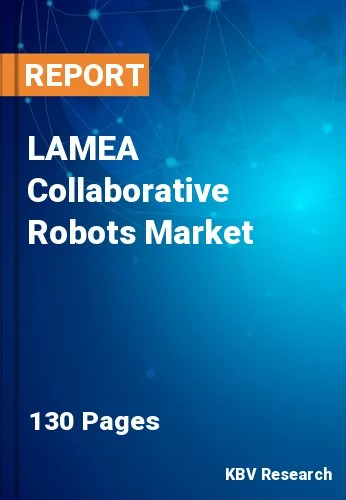The Latin America, Middle East and Africa Collaborative Robots Market would witness market growth of 42.6% CAGR during the forecast period (2022-2028).
These robots are being used by businesses to streamline their operations. To enhance profitability, quality, and employee happiness, for example, Tomenson Machine Works automated its pin stamping application. The business bought an OnRobot RG6 gripper and a Universal Robots UR3 cobot arm, that can work with a wide range of item sizes and are being utilized for prospective tasks like machine tending, packaging, and deburring.
Additionally, market vendors are involved in mergers and acquisitions. For instance, in April 2020, the automation company HAHN Group purchased the robotics integrator DAHL Automation, which specializes in collaborative robot arms. The company would increase its market share in intralogistics and mobile, autonomous robots as a result of this acquisition. Delivery costs can be significantly reduced with the use of automation systems. This is supported by the developments in robot technology that enable businesses across a variety of industries to function independently and with increased human capabilities.
The deployment is being influenced in large part by longer onboarding and training programmes, rising benefits and compensation rates, and workforce shortages. The number of warehouses, distribution centres, and fulfilment centres spending in automated solutions is growing. A greater proportion of manufacturing organizations worldwide are implementing robotics as technology advances and the applications grow more varied and versatile.
Two countries who are still in the initial stages of technological adoption and development are those in Africa and the Middle East. On the other hand, the region's economic outlook is unfavourable and will primarily depend on how well private and public sector initiatives and investments perform. Additionally, a lot of businesses in this region are implementing cutting-edge automation tools like packaging robots to cut costs and improve operational effectiveness.
The Brazil market dominated the LAMEA Collaborative Robots Market by Country in 2021, and would continue to be a dominant market till 2028; thereby, achieving a market value of $161.1 million by 2028. The Argentina market would witness a CAGR of 43.4% during (2022 - 2028). Additionally, The UAE market would exhibit a CAGR of 42.3% during (2022 - 2028).
Based on Application, the market is segmented into Assembly, Handling, Quality Testing, Packaging, Pick & Place, Machine Tending, Gluing & Welding and Others. Based on Component, the market is segmented into Hardware and Software. Based on Payload, the market is segmented into Up to 5kg, Up to 10kg and Above 10kg. Based on Vertical, the market is segmented into Automotive, Food & Beverage, Furniture & Equipment, Electronics, Plastic & Polymers, Metal & Machinery, Pharma and Others. Based on countries, the market is segmented into Brazil, Argentina, UAE, Saudi Arabia, South Africa, Nigeria, and Rest of LAMEA.
Free Valuable Insights: The Global Collaborative Robots Market is Predict to reach $10.8 Billion by 2028, at a CAGR of 40.1%
The market research report covers the analysis of key stake holders of the market. Key companies profiled in the report include ABB Group, Robert Bosch GmbH, Denso Corporation, Seiko Epson Corporation, FANUC Corporation, Yaskawa Electric Corporation, Teradyne, Inc. (Universal Robots A/S), Techman Robot, Inc. (Quanta Storage, Inc.), Stellantis N.V. (Comau S.P.A), and Kuka AG (Midea Investment Holding Co., Ltd.)
By Application
By Component
By Payload
By Vertical
By Country
Our team of dedicated experts can provide you with attractive expansion opportunities for your business.

